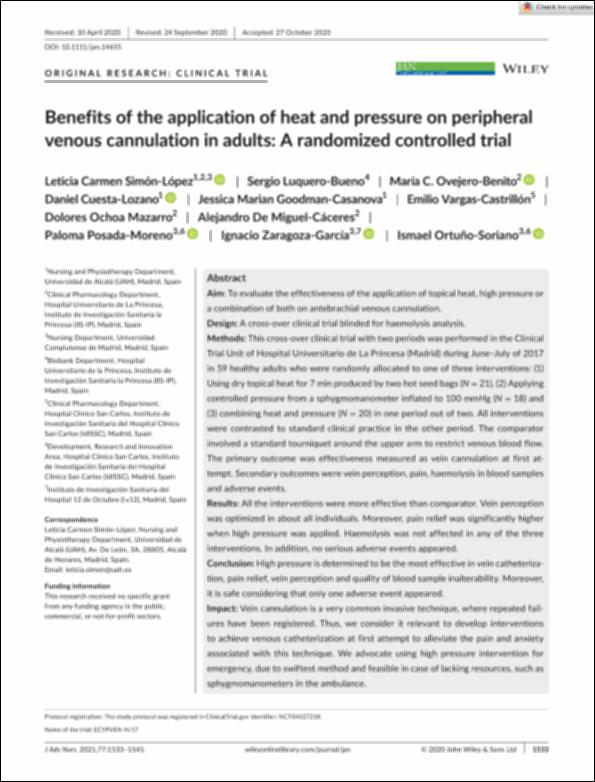Por favor, use este identificador para citar o enlazar este ítem:
http://hdl.handle.net/10637/14770Benefits of the application of heat and pressure on peripheral venous cannulation in adults: A randomized controlled trial
| Título : | Benefits of the application of heat and pressure on peripheral venous cannulation in adults: A randomized controlled trial |
| Autor : | Luquero Bueno, Sergio Ovejero Benito, María del Carmen Cuesta Lozano, Daniel Goodman Casanova, Jessica Marian Vargas Castrillón, Emilio Ochoa Mazarro, Dolores Miguel Cáceres, Alejandro de Posada Moreno, Paloma Zaragoza García, Ignacio Ortuño Soriano, Ismael Simón López, Leticia Carmen |
| Materias: | Dry heat; Nursing; Peripheral venous catheterization; Tourniquet; Venipuncture |
| Editorial : | Wiley |
| Citación : | Simón-López LC, Luquero-Bueno S, Ovejero-Benito MC, et al. Benefits of the application of heat and pressure on peripheral venous cannulation in adults: A randomized controlled trial. J Adv Nurs. 2021;77:1533–1545. https://doi.org/10.1111/jan.14655 |
| Resumen : | Aim: To evaluate the effectiveness of the application of topical heat, high pressure or a combination of both on antebrachial venous cannulation. Design: A cross-over clinical trial blinded for haemolysis analysis. Methods: This cross-over clinical trial with two periods was performed in the Clinical Trial Unit of Hospital Universitario de La Princesa (Madrid) during June–July of 2017 in 59 healthy adults who were randomly allocated to one of three interventions: (1) Using dry topical heat for 7 min produced by two hot seed bags (N = 21), (2) Applying controlled pressure from a sphygmomanometer inflated to 100 mmHg (N = 18) and (3) combining heat and pressure (N = 20) in one period out of two. All interventions were contrasted to standard clinical practice in the other period. The comparator involved a standard tourniquet around the upper arm to restrict venous blood flow. The primary outcome was effectiveness measured as vein cannulation at first attempt. Secondary outcomes were vein perception, pain, haemolysis in blood samples and adverse events. Results: All the interventions were more effective than comparator. Vein perception was optimized in about all individuals. Moreover, pain relief was significantly higher when high pressure was applied. Haemolysis was not affected in any of the three interventions. In addition, no serious adverse events appeared. Conclusion: High pressure is determined to be the most effective in vein catheterization, pain relief, vein perception and quality of blood sample inalterability. Moreover, it is safe considering that only one adverse event appeared. Impact: Vein cannulation is a very common invasive technique, where repeated failures have been registered. Thus, we consider it relevant to develop interventions to achieve venous catheterization at first attempt to alleviate the pain and anxiety associated with this technique. We advocate using high pressure intervention for emergency, due to swiftest method and feasible in case of lacking resources, such as sphygmomanometers in the ambulance. |
| URI : | http://hdl.handle.net/10637/14770 |
| Derechos: | http://creativecommons.org/licenses/by-nc-nd/4.0/deed.es openAccess |
| ISSN : | 1365-2648 |
| Fecha de publicación : | 27-oct-2020 |
| Centro : | Universidad San Pablo-CEU |
| Aparece en las colecciones: | Facultad de Farmacia |
Los ítems de DSpace están protegidos por copyright, con todos los derechos reservados, a menos que se indique lo contrario.


